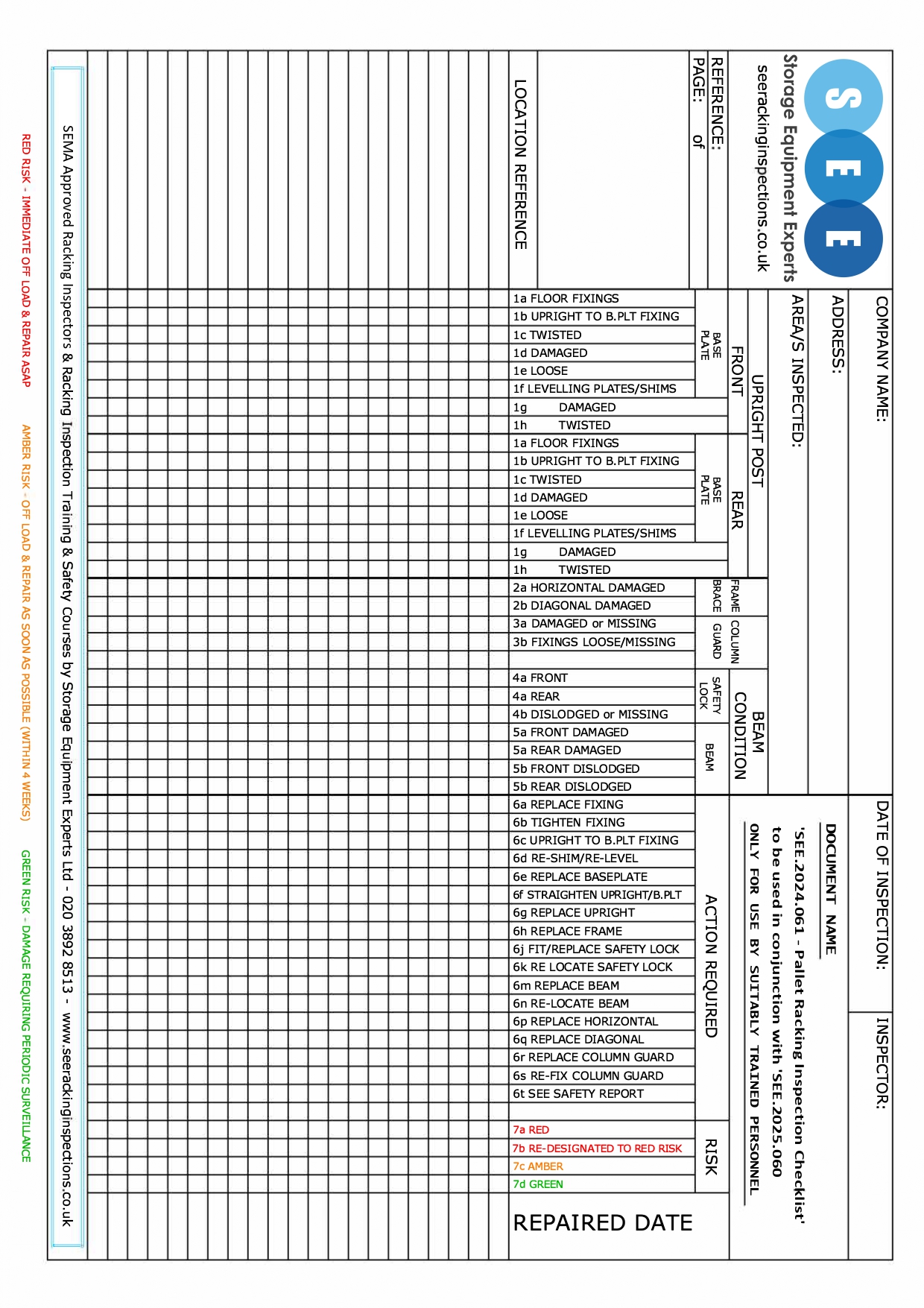We have created a ‘Racking Inspection Checklist’ form with a detailed guide which can be used to carry out an internal (i.e. by company trained staff) inspection of the APR Systems (Adjustable Pallet Racking).
Owners and users of pallet racking systems should be aware of the importance of maintaining the safety of these types of storage systems.
This would include:
- Training for employees that use the pallet racking systems along with information and instruction on the safe operation of the racking system.
- A system in place for staff to immediately report any damage or defects.
- Regular inspections of the pallet racking systems by internal staff & at least once every 12 months by a SEMA Approved Inspector.
- Keep records of all inspections, damage and completed repairs.
Our racking inspection checklist will help to understand the types of damage and defects that might be found during an inspection of your pallet racking.
What is a Pallet Racking Inspection?
A Pallet Racking Inspection is a detailed visual assessment of all areas of a pallet racking system and would generally be carried out from ground level unless there are indications of problems at high level that need investigation.
Who should carry out a Pallet Racking Inspection?
Inspections of pallet racking should be completed at least once every 12 months by a SEMA Approved Inspector and more frequently by internal staff.
Persons responsible for carrying out internal inspections should attend a one day ‘Rack Safety Awareness’ course to receive the necessary training.
How often should we carry out the internal Pallet Racking Inspections?
Internal inspections could be daily, weekly, or monthly.
Deciding the frequency of these inspections would be based on a risk assessment of the warehouse environment and the pallet racking systems within. This risk assessment should be completed by the nominated ‘person responsible for racking safety’ (PRRS). This will take into account the frequency and method of operation together with the dimensions of the warehouse, the equipment used and personnel involved, all of which could damage the structure.
Our Racking Inspection Checklist forms have been created for use by appropriately trained internal staff to complete their internal inspections but are not intended to cover every aspect of a pallet racking inspection and it is the responsibility of the person/s carrying out the inspection to be aware of and record/categorise any type of damage, faults or risks related to the storage equipment.

Disclaimer
The information within this document ‘SEE.2025.060 – Pallet racking inspection checklist’ and the related document ‘SEE.2024.061 – Pallet racking inspection checklist’ is for general guidance and should be used only by correctly trained and qualified persons. These documents do not cover every aspect of pallet racking inspections and it is the responsibility of the person/s carrying out an inspection to be aware of and record/categorise any type of damage, faults or risks related to the storage equipment.
Repairs to pallet racking equipment should only be carried out by suitable trained and qualified persons and should be in accordance with requirements of the manufacturer of your equipment.
If in any doubt, you should consult a SEMA Approved Racking Inspector for specific advice before using or acting on any of the information contained within this document ‘SEE.2025.060 – Pallet racking inspection checklist’ and the related document ‘SEE.2024.061 – Pallet racking inspection checklist’.
You should never attempt to carry out any activity which may put you or others at risk or which may cause damage to your or anyone else’s property.
To the extent permitted by law, we accept no responsibility (including loss, damage or injury) for your use of the information contained within this document ‘SEE.2025.060 – Pallet racking inspection checklist’ and the related document ‘SEE.2024.061 – Pallet racking inspection checklist’.
